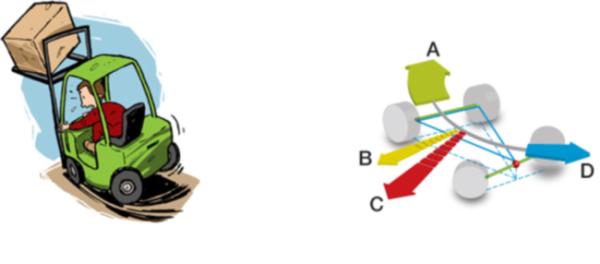Complete Powerpoint slide presentation for forklift instructors. Ready made training course
The dynamic forces at work during forklift truck operation

A = Direction of travel. B = Centrifugal force. C = Nett force. D = Acceleration force
Worse still are the dynamic forces caused by turning – which push the truck sideways in the opposite direction of the truck’s turning direction. See figure above
These forces may be small at low speeds, but they do move the CCOG and with an elevated load there is a very small triangle to keep the CCOG within. This is why properly trained drivers will never manoeuvre or travel with an elevated load.
No load, no danger?
Driving without a load is not a guarantee against a truck overturning. Unloading a vehicle moves the CCOG to the rear, increasing the risk of tip over. And this is frequently seen when joyriding in an unloaded truck. Forklifts are designed for maneuverability and pulling power – not performing sharp turns at speed or harsh braking.
On solid ground
The stability principles work fine on flat solid ground, but where there is any form of gradient at all, stability will quickly become critical. Working on ramps is common for forklifts, but trucks are their most vulnerable here if the load is elevated. For this reason trucks should always reverse downhill with the load as low as possible.
Outdoors, the dangers increases greatly. A wheel going down a small hole or up on a small ramp while the load is high can be sufficient to tip the truck over.
Attachments
If an attachment is used – like a bale clamp – the increased front-end weight moves the CCOG much further forward... significantly increasing the possibility of the truck tipping forwards. It is vital, therefore, for a driver to fully understand the changed performance characteristics of a forklift with an attachment.
Their lives in your hands
Remember, there is no such thing as a forklift truck accident. An ‘accident’ is an incident of bad driving, bad training, bad maintenance, a bad working environment or any combination of these.
- Action points
- Ensure all your forklifts have an operator restraint.
- Ensure all drivers always wear an operator restraint or seatbelt at all times – and challenge those who do not.
Invest in driver training – and refresher courses – ensuring an understanding of safe practice.
Disclaimer. The legislative information contained on this web site is my interpretation of the law based on many years in the health and safety business. A definitive interpretation can only be given by the courts. I will therefore not be held responsible for any accident/incident/prosecution arising as a consequence of anyone using any information obtained from this web site.